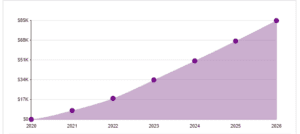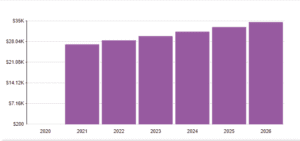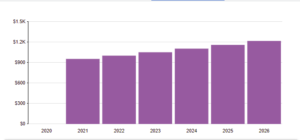Case – Total Rewards in Practice
Employees are the most important resources in an organization. Employees’ wellness largely contributes to the productivity and overall performance of an organization. When the employees are sick and unwell, it reduces the efficiency of performing the assigned roles and responsibilities. A wellness program acts as a form of motivation for employees. Such programs reduce the costs that would be incurred in healthcare, reduce the rate of absenteeism and presenteeism in an organization (Lowensteyn et al., 2018). Particularly, most organizations provide health insurance services for employees. Therefore, when the rate of hospitalization among employees is high, the health insurance expenses increase. The reduction in healthcare costs can be due to the reduced probability of contracting diseases due to lifestyle behaviors such as smoking. Besides several benefits on healthcare costs, employee wellness has proven to impact organizational culture positively. Currently, organizations have recognized the need for employee wellness programs, which is evidenced by flexible work schedules, provision of facilities such as playgrounds, and staff athletic competitions to keep employees healthy. The current analysis aims to conduct a quantitative reasoning activity to establish the possible impact on healthcare costs, absenteeism, and presenteeism of a wellness program and the overall cost of healthcare to come up with appropriate recommendations for the employer and employees.
Do you need help with your assignment ? Get in touch with us. We undertake to provide you with excellent service.
Annual Healthcare Costs
From the analysis conducted using the Online ROI Calculator, the costs incurred in healthcare are increasing without a wellness program (Aldana, 2020). Considering an organization with 150 employees, annual healthcare costs increase presently by 5%. With 33% and 20% of employees being obese and smokers, respectively, the annual healthcare cost is $1,780,000. This is attributable to the healthcare diseases associated with obesity and smoking and employees who are generally unhealthy. The annual increase in healthcare for 2019 and 2020 is 5%. Considering an increase in the number of employees to 200 after five years in 2025, the cost of healthcare will increase by 21% to $2,271,788. This indicates that the organization incurs more healthcare expenses, which may cause a loss of revenue for the employees and the employer. This makes an employee wellness program crucial for the organization since it can enable the organization to save on healthcare costs and, at the same time, increase employee motivation and overall efficiency. Ott-Holland, Shepherd, and Ryan (2019) note that although the benefits of the wellness program may not necessarily be short-term, the organization can consider it a long-term venture.
Absenteeism
Absenteeism in an organization may be due to sickness, among other reasons, which forces employees to skip workdays seeking medication and recovering. Absenteeism due to sickness cannot be substituted, especially when it happens without prior notice. This leads to reduced productivity in the department and the organization at large (Song & Baicker, 2019). The reduced productivity even increases when the employee is absent for several days. Further, substituting the employee’s role with another employee who is inexperienced in the role also reduces efficiency. A higher number of employees implies that the rates of absenteeism also increase. Considering an organization with 150 employees, the annual healthcare cost due to absenteeism is $154,950. The cost is projected to increase by 3% to $160,373 if a wellness program is not implemented. However, with the implementation of a wellness program, the cost was reduced by 3% to $155,506. When the number of employees increases to 200 in 2025, the annual healthcare cost becomes $245,376 when there is no wellness program and reduces by 21% to $193,320 when there is a wellness program.
Presenteeism
Presenteeism is a situation where employees are physically present at work but do not contribute to the organization’s productivity. A wellness program motivates employees by providing an opportunity for health and fitness. This motivates employees to actively participate in their daily roles and perform daily tasks. For instance, group activities will motivate unity among employees and discourage presenteeism since employees have a role to play in a team and will want to contribute to the success of the team (Armstrong, 2007). Considering an organization with 150 employees, with 33% being obese and 20% being smokers, the annual cost incurred in healthcare is $2 670 000. The costs increase by 7% to $2 860,171 without a wellness program. The costs decrease by 7% to $2 791,064 with a wellness program. In 2025, the cost of healthcare will increase by 13% to $3,171,122 without a wellness program and reduce by 3% to $2,952,117 when a wellness program is implemented.
Conclusively, the analysis indicates that a wellness program reduces the costs incurred on healthcare by an organization as well as reducing absenteeism and presenteeism. Presenteeism contributes to reduced productivity due to a lack of enthusiasm and motivation among employees due to underlying health conditions. Implementing a wellness program and embracing healthy behaviors contributes to wellness and healthy living free from diseases associated with habits such as smoking and obesity. Implementing a functional wellness program is essential for every organization. Employees should be encouraged to ensure that their health is fit since it contributes to organizational productivity and performance, as Verasai (2020) suggests. A wellness program may seem ineffective in the short term, although it becomes beneficial in the long term. Therefore, employees should not regard a wellness program as a liability but as an organizational necessity that contributes to organizational efficiency, productivity, and profitability.
References
Aldana, S. (2020, January 2). Wellness ROI vs VOI: The Best Employee Well-being Programs Use Both. Retrieved from https://www.wellsteps.com/blog/2018/01/10/wellness-roiemployee-wellbeing-programs/.
Armstrong, M. (2007). A handbook of employee reward management and practice. Philadelphia: Kogan Page
Lowensteyn, I., Berberian, V., Belisle, P., DaCosta, D., Joseph, L., & Grover, S. A. (2018). The measurable benefits of a workplace wellness program in Canada. Journal of occupational and environmental medicine, 60(3), 211-216.
Ott-Holland, C. J., Shepherd, W. J., & Ryan, A. M. (2019). Examining wellness programs over time: Predicting participation and workplace outcomes. Journal of Occupational Health Psychology, 24(1), 163.
Song, Z., & Baicker, K. (2019). Effect of a workplace wellness program on employee health and economic outcomes: a randomized clinical trial. Jama, 321(15), 1491-1501.
Verasai, A. (2020, September 12). Importance of employee wellness in an organization. The HR Digest. https://thehrdigest.com/importance-of-employee-wellness-in-an-organization/
Appendices
| Health Care Costs: | ||||||||
| Health Care Costs: | Annual Health Care Costs | Annual Cost Increase | Number of Employees | % of employees obese | % that are smokers | Target percent obese | Target percent smokers | |
| 2019 | $1, 780,000 | 5% | 150 | 33% | 20% | 55% | 15% | |
| 2020 projected | $1, 869,000 | 5% | 150 | 33% | 20% | 55% | 15% | |
| 2025 projected | $2,271,781 | 21% | 200 | 33% | 20% | 55% | 15% | |
| Absenteeism: | ||||||||
| Absenteeism: | Annual Health Care Costs | Annual Cost Increase | Number of Employees | % of employees obese | % that are smokers | Target percent obese | Target percent smokers | |
| 2019 | $154,950 | 150 | 33% | 20% | 55% | 15% | ||
| 2022 Do Nothing | $160,373 | 3% | 150 | 33% | 20% | 55% | 15% | |
| 2022 Wellness Program Impact | $155,506 | -3% | 150 | 33% | 20% | 55% | 15% | |
| 2025 Do Nothing | $245,376 | 57% | 200 | 33% | 20% | 55% | 15% | |
| 2025 Wellness Program
Impact |
$193,320 | -21% | 200 | 33% | 20% | 55% | 15% |
|
| Presenteeism: | ||||||||
| Presenteeism: | Annual Health Care Costs | Annual Cost Increase | Number of Employees | % of employees obese | % that are smokers | % of employees 1 or more risk factors. | Target percent obese | Target percent smokers |
| 2019 | $2,670,000 | 150 | 33% | 20% | 5% | 55% | 15% | |
| 2022 Do Nothing | $2,860,171 | 7% | 150 | 33% | 20% | 5% | 55% | 15% |
| 2022 Impact of Wellness | $2,791064 | -2% | 150 | 33% | 20% | 5% | 55% | 15% |
| 2025 Do Nothing | $3,171,122 | 13% | 200 | 33% | 20% | 5% | 55% | 15% |
| 2025 Impact of Wellness Program | $2,952,117 | -7% | 200 | 33% | 20% | 5% | 55% | 15% |
Figure 1: Savings Projected Upon Implementation of a Wellness Program
Figure 2: Projected Costs Without a Wellness Program
Figure 3: Projected Savings in Healthcare upon Reduced Obesity
Figure 4: Projected Savings in Healthcare upon Reduced Smoking
ORDER A PLAGIARISM-FREE PAPER HERE
We’ll write everything from scratch
Question
In this assignment, your quantitative reasoning skills will be assessed at the “introduced” level. The Quantitative Reasoning rubric will be useful for this purpose. Then, in HRM520, your quantitative reasoning skills will be further assessed at the “reinforced” level. Finally, in HRM599, your skills will be assessed at the “mastered” level.

Case – Total Rewards in Practice
Case Assignment
This assignment requires you to:
Use online calculators to determine what impact wellness programs might have on an organization’s health care costs, absenteeism, and presenteeism. The assignment also shows the risks of doing nothing to try to curb health insurance, absenteeism, and presenteeism costs.
To carry out the assignment, you are required to:
Complete 3 tables—one each for Health Care Costs, Absenteeism, and Presenteeism.
Use relevant data that you find from reputable sources for annual health care costs, number of employees, percent obese, and percent smokers. [If you cannot readily find actual data from searching sources, use fictitious data that seems realistic to you.] Select your own targets for percent obese and percent smokers.
To utilize your quantitative reasoning skills, it is important you analyze, synthesize, and accurately report your findings in a 3-page paper (not counting the title page, reference page, or appendices).
Feel free to use the same data for each table, but you should try to use examples of data that show significant differences when calculated.
Follow this link to the calculators: https://www.wellsteps.com/roi/
Additional information can be found at https://www.wellsteps.com/resources/tools/.
Calculate the possible impact on health care costs, absenteeism, and presenteeism of wellness programs.
Prepare three tables in Word to show the data you choose. Your tables should be set up like this:
Health Care Costs:
Health Care Costs:
Annual Health Care Costs
Annual Cost Increase
Number of Employees
% of employees obese
% that are smokers
Target percent obese
Target percent smokers
2019
2020 projected
2025 projected
Absenteeism:
Absenteeism:
Annual Health Care Costs
Annual Cost Increase
Number of Employees
% of employees obese
% that are smokers
Target percent obese
Target percent smokers
2019
2022 Do Nothing
2022 Wellness Program Impact
2025 Do Nothing
2025 Wellness Program
Impact
Presenteeism:
Presenteeism:
Annual Health Care Costs
Annual Cost Increase
Number of Employees
% of employees obese
% that are smokers
% of employees 1 or more risk factors.
Target percent obese
Target percent smokers
2019
2022 Do Nothing
2022 Impact of Wellness
2025 Do Nothing
2025 Impact of Wellness Program
Using critical thinking skills to prepare your narrative, you should summarize and analyze the data. Do not merely repeat the numbers without analyzing the findings and making recommendations for employers (and employees).





